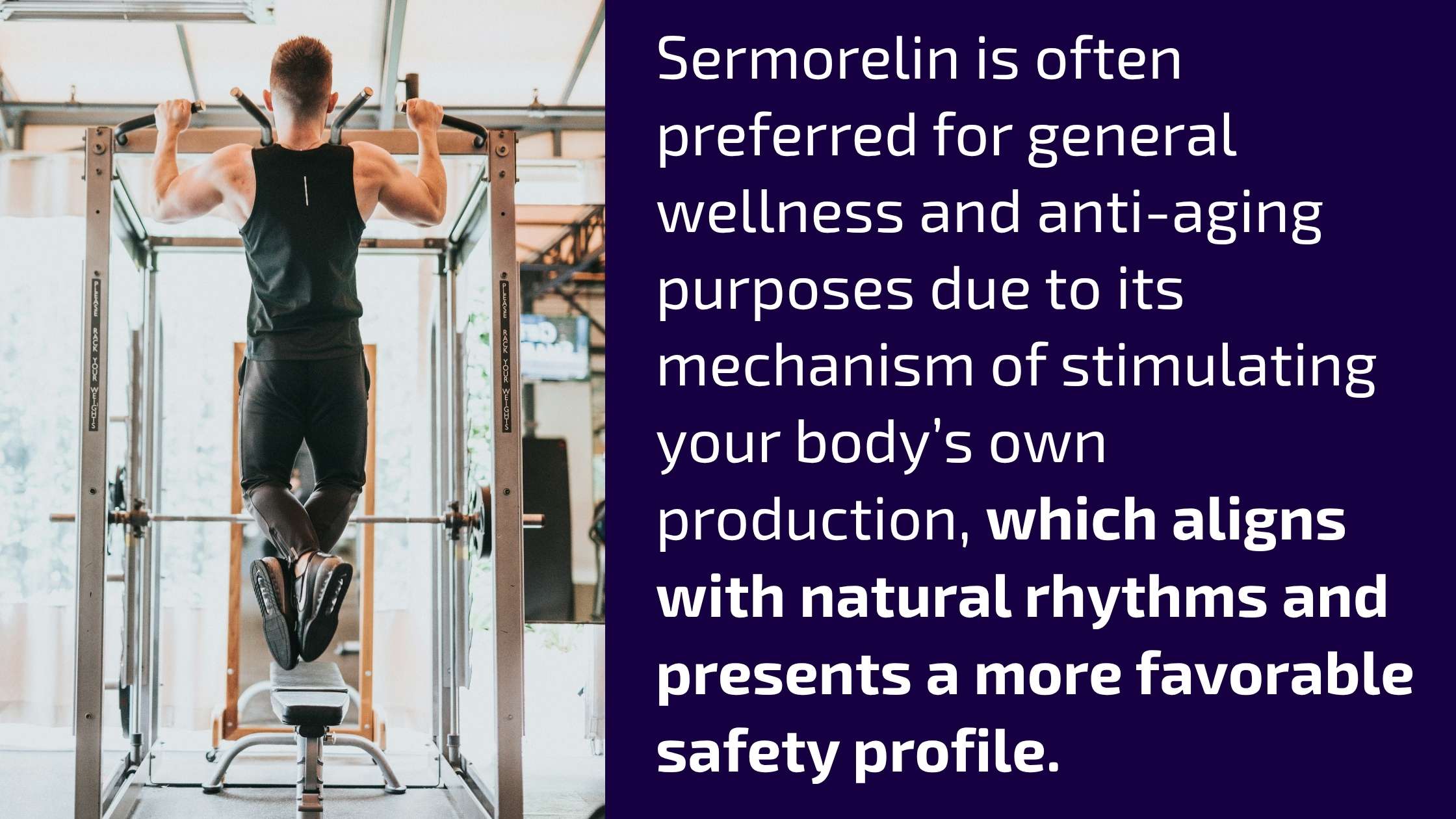Sermorelin vs. HGH: Which is the Right Choice for You?
In the ongoing pursuit of aging well, therapies aimed at optimizing hormone levels are becoming increasingly popular. Two of the most discussed treatments are Sermorelin and Human Growth Hormone (HGH). You’ve likely heard them mentioned in conversations about improving energy, building lean muscle, and enhancing recovery. And if you haven't, you probably will soon. But this raises a crucial question: What is the difference, and which one is the right, safe choice for your health goals?
The short answer is that HGH therapy involves the direct replacement of human growth hormone, while Sermorelin therapy stimulates your body to produce more of its own HGH. As a leader in telehealth dedicated to patient safety and education, we believe the full answer is more nuanced. The best choice depends on your unique physiology, your wellness goals, and most importantly, the quality and supervision of your treatment plan.
This short video also explains Sermorelin:
What Exactly is Human Growth Hormone (HGH)?
Human Growth Hormone, or HGH, is a peptide hormone produced by your pituitary gland. It acts as a key signaling molecule that plays a fundamental role in numerous bodily functions, including:
- Growth during childhood and adolescence.
- Regulating body composition, muscle, and bone growth.
- Repairing cells and supporting a healthy metabolism.
- Boosting immune system function.
As we age, the natural production of HGH by the pituitary gland begins to decline. This reduction is linked to common signs of aging like decreased energy, loss of muscle mass, and slower recovery. HGH therapy addresses this by introducing a synthetic, bioidentical version of the hormone directly into the body to restore optimal levels.
A Key Consideration: HGH and Your Body's Natural Production
A critical factor to understand about HGH therapy is its effect on your body’s own production. Using synthetic HGH causes your body to significantly reduce, and often temporarily stop, producing its own natural HGH. This happens because of a biological mechanism called a negative feedback loop.
Think of it like the thermostat in your house. Your pituitary gland is the central furnace. If you bring in a powerful portable space heater (synthetic HGH) and turn it on high, the thermostat will sense that the room is warm and shut off the furnace. Similarly, when you introduce external HGH, your brain's "sensor" detects the high levels and signals your pituitary gland to halt its own production.
According to a review on growth hormone physiology from the National Center for Biotechnology Information, this feedback system is tightly regulated by hormones from the hypothalamus - GHRH (the "Go" signal) and somatostatin (the "Stop" signal). Direct HGH therapy disrupts this balance by creating high hormone levels that promote the "Stop" signal, effectively shutting down the natural factory. For most people using medically appropriate doses, this shutdown is temporary and function returns after stopping therapy. However, it highlights a significant disruption to your natural endocrine function.
What Exactly is Sermorelin?
This is where Sermorelin presents a fundamental difference. It is what’s known as a "secretagogue," or a growth hormone-releasing hormone (GHRH) analogue. Instead of replacing your body's growth hormone, Sermorelin works by stimulating your pituitary gland, encouraging it to produce and release more of its own natural HGH.
By using Sermorelin, you are essentially turning up the "Go" signal, allowing your body's own furnace to produce more heat. A review in Clinical Interventions in Aging highlights that this method preserves the natural feedback loops and represents a more physiological approach to managing adult-onset growth hormone decline.
Why Boost Growth Hormone Levels? The Link to Lean Muscle and Metabolism 💪
So, why would someone want to supplement with HGH or Sermorelin in the first place? The ultimate goal is to combat the effects of age-related hormone decline, primarily by increasing or maintaining lean muscle mass to support metabolic health.
As growth hormone levels drop with age, many people experience sarcopenia (age-related muscle loss) and a noticeable slowdown in their metabolism. This is significant because muscle is a metabolically active tissue. The more lean muscle you have, the more calories your body burns at rest and the more efficiently it manages blood sugar.
Restoring growth hormone to more youthful levels can directly counteract these changes. A landmark study in the New England Journal of Medicine demonstrated that men over 60 who received HGH saw a significant increase in lean body mass and a decrease in fat tissue after just six months, without any changes in diet or exercise. This shift in body composition is key to a robust metabolism.
Why a Doctor-Supervised Approach is Non-Negotiable
The choice between Sermorelin and HGH isn't one to be made lightly. As we've seen, these substances impact the body in very different ways. The safety and effectiveness of any hormone therapy hinge on professional medical guidance.
When considering these therapies, you must be vigilant about:
- Product Quality and Purity: Unregulated sources are a serious risk.
- Accurate Diagnosis: Only a provider can perform the necessary blood tests to determine if a hormone imbalance exists.
- Personalized Dosing: The correct dosage is highly individual to avoid side effects and pituitary suppression.
At GobyMeds, our process is built on a foundation of medical expertise to create a personalized plan that is both safe and effective for you.
The GobyMeds Difference: Our Commitment to Your Safety
At GobyMeds, our core mission is to provide safe, effective, and affordable health solutions. We set ourselves apart from the competition by prioritizing your well-being above all else. Here's how we ensure the safety and efficacy of our hormone therapy programs:
- Top-Tier, Vetted Pharmacies: We partner exclusively with pharmacies that are accredited and licensed in the United States.
- LegitScript Certified: GobyMeds is proud to be LegitScript certified, the gold standard for verifying the legitimacy and compliance of online healthcare platforms.
- Expert Medical Supervision: Every program at GobyMeds is overseen by a licensed medical provider who conducts a thorough health evaluation before prescribing any treatment.
- Exceptional Customer Service: Our dedicated team is committed to supporting you at every step.
Potential Side Effects
When administered correctly, both therapies have a strong safety profile. However, their mechanisms lead to different considerations.
- Sermorelin: Side effects are generally mild and infrequent, most commonly temporary reactions at the injection site like flushing or redness. Because it works with your body's systems, the risk of over-supplementation is lower.
- HGH: Because it bypasses the body's natural regulation, improper dosing can lead to side effects. Research from The Journal of Clinical Endocrinology & Metabolism confirms that while HGH effectively improves body composition, it can also cause joint pain (arthralgia), fluid retention (edema), and carpal tunnel syndrome.
Conclusion

So, is Sermorelin or HGH the better choice? While both can be effective, Sermorelin is often preferred for general wellness and anti-aging purposes due to its mechanism of stimulating your body’s own production, which aligns with natural rhythms and presents a more favorable safety profile.
Ultimately, the most important decision you’ll make is not which peptide to use, but which provider to trust. Your health is too valuable to risk on unregulated products and unsupervised protocols. With GobyMeds, you get transparent pricing, premium products from accredited U.S. pharmacies, and the dedicated expert support you deserve.
Ready to see if sermorelin is the right choice for you? Click here to learn more and get started today!
References
- Blackman, M. R., et al. (2002). Effects of growth hormone and/or sex steroid administration on body composition in healthy elderly women and men. The Journal of Clinical Endocrinology & Metabolism, 87(8), 3701–3710.
- Rudman, D., et al. (1990). Effects of human growth hormone in men over 60 years old. New England Journal of Medicine, 323(1), 1–6.
- Vance, M. L. (2023). Physiology, Growth Hormone. In: StatPearls. StatPearls Publishing. Retrieved from: https://www.ncbi.nlm.nih.gov/books/NBK482377/
- Walker, R. F. (2006). Sermorelin: a better approach to management of adult-onset growth hormone insufficiency? Clinical Interventions in Aging, 1(4), 307–308.




.svg)